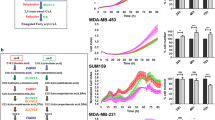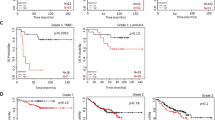Abstract
Purpose
HER2-positive breast cancer has a high chance of achieving pathological complete response when HSD17B4, responsible for peroxisomal β-oxidation of very long-chain fatty acids (VLCFA) and estradiol, is methylation-silenced. Here, we aimed to identify the underlying molecular mechanism.
Methods
Using a HER2-positive breast cancer cell line, BT-474, control and knock-out (KO) clones were obtained. Metabolic characteristics were analyzed using a Seahorse Flux analyzer.
Results
HSD17B4 KO suppressed cellular proliferation, and enhanced sensitivity to lapatinib approximately tenfold. The KO led to accumulation of VLCFA and a decrease of polyunsaturated fatty acids (PUFAs), such as docosahexaenoic acid (DHA) and arachidonic acid. HSD17B4 KO increased Akt phosphorylation, possibly via decreased DHA, and genes involved in oxidative phosphorylation (OxPhos) and electron transport chain (ETC) were upregulated. Increased mitochondrial ATP production in the KO cells was confirmed by extracellular flux analyzer. Increased OxPhos led to severe dependence of the KO cells on pyruvate from glycolysis. Suppression of glycolysis by lapatinib led to severe delayed suppression of OxPhos in KO cells.
Conclusion
HSD17B4 KO in BT-474 cells caused a decrease of PUFAs, increased Akt phosphorylation, enhanced glucose dependence of OxPhos, and increased sensitivity to inhibition of HER2, upstream of Akt. This mechanism may be applicable to other HER2-positive glucose-dependent breast cancer cells with HSD17B4 silencing.





Similar content being viewed by others
Data availability
All data generated or analyzed during this study are included in this published article and its supplementary information files.
Abbreviations
- HSD17B4 :
-
Hydroxysteroid 17-β Dehydrogenase 4
- OxPhos :
-
Oxidative phosphorylation
References
Loibl S, Jackisch C, Schneeweiss A, Schmatloch S, Aktas B, Denkert C, Wiebringhaus H, Kümmel S, Warm M, Paepke S, Just M, Hanusch C, Hackmann J, Blohmer JU, Clemens M, Dan Costa S, Gerber B, Engels K, Nekljudova V, von Minckwitz G, Untch M (2017) Dual HER2-blockade with pertuzumab and trastuzumab in HER2-positive early breast cancer: a subanalysis of data from the randomized phase III GeparSepto trial. Ann Oncol 28:497–504. https://doi.org/10.1093/annonc/mdw610
Broglio KR, Quintana M, Foster M, Olinger M, McGlothlin A, Berry SM, Boileau JF, Brezden-Masley C, Chia S, Dent S, Gelmon K, Paterson A, Rayson D, Berry DA (2016) Association of pathologic complete response to neoadjuvant therapy in HER2-positive breast cancer with long-term outcomes: a meta-analysis. JAMA Oncol 2:751–760. https://doi.org/10.1001/jamaoncol.2015.6113
Tolaney SM, Guo H, Pernas S, Barry WT, Dillon DA, Ritterhouse L, Schneider BP, Shen F, Fuhrman K, Baltay M, Dang CT, Yardley DA, Moy B, Marcom PK, Albain KS, Rugo HS, Ellis MJ, Shapira I, Wolff AC, Carey LA, Overmoyer B, Partridge AH, Hudis CA, Krop IE, Burstein HJ, Winer EP (2019) Seven-year follow-up analysis of adjuvant paclitaxel and Trastuzumab trial for node-negative, human epidermal growth factor receptor 2-positive breast cancer. J Clin Oncol 37:1868–1875. https://doi.org/10.1200/jco.19.00066
Kuerer HM, Vrancken Peeters M, Rea DW, Basik M, De Los SJ, Heil J (2017) Nonoperative management for invasive breast cancer after neoadjuvant systemic therapy: conceptual basis and fundamental international feasibility clinical trials. Ann Surg Oncol 24:2855–2862. https://doi.org/10.1245/s10434-017-5926-z
Shigematsu H, Fujisawa T, Shien T, Iwata H (2020) Omitting surgery for early breast cancer showing clinical complete response to primary systemic therapy. Jpn J Clin Oncol 50:629–634. https://doi.org/10.1093/jjco/hyaa055
Fujii S, Yamashita S, Yamaguchi T, Takahashi M, Hozumi Y, Ushijima T, Mukai H (2017) Pathological complete response of HER2-positive breast cancer to trastuzumab and chemotherapy can be predicted by HSD17B4 methylation. Oncotarget 8:19039–19048. https://doi.org/10.18632/oncotarget.15118
Yamashita S, Hattori N, Fujii S, Yamaguchi T, Takahashi M, Hozumi Y, Kogawa T, El-Omar O, Liu YY, Arai N, Mori A, Higashimoto H, Ushijima T, Mukai H (2020) Multi-omics analyses identify HSD17B4 methylation-silencing as a predictive and response marker of HER2-positive breast cancer to HER2-directed therapy. Sci Rep 10:15530. https://doi.org/10.1038/s41598-020-72661-9
Labrie F, Luu-The V, Lin SX, Labrie C, Simard J, Breton R, Belanger A (1997) The key role of 17 beta-hydroxysteroid dehydrogenases in sex steroid biology. Steroids 62:148–158
Holliday DL, Speirs V (2011) Choosing the right cell line for breast cancer research. Breast Cancer Res 13:215. https://doi.org/10.1186/bcr2889
Neve RM, Chin K, Fridlyand J, Yeh J, Baehner FL, Fevr T, Clark L, Bayani N, Coppe JP, Tong F, Speed T, Spellman PT, DeVries S, Lapuk A, Wang NJ, Kuo WL, Stilwell JL, Pinkel D, Albertson DG, Waldman FM, McCormick F, Dickson RB, Johnson MD, Lippman M, Ethier S, Gazdar A, Gray JW (2006) A collection of breast cancer cell lines for the study of functionally distinct cancer subtypes. Cancer Cell 10:515–527. https://doi.org/10.1016/j.ccr.2006.10.008
Xia W, Gerard CM, Liu L, Baudson NM, Ory TL, Spector NL (2005) Combining lapatinib (GW572016), a small molecule inhibitor of ErbB1 and ErbB2 tyrosine kinases, with therapeutic anti-ErbB2 antibodies enhances apoptosis of ErbB2-overexpressing breast cancer cells. Oncogene 24:6213–6221. https://doi.org/10.1038/sj.onc.1208774
Leonard AE, Kelder B, Bobik EG, Chuang LT, Lewis CJ, Kopchick JJ, Mukerji P, Huang YS (2002) Identification and expression of mammalian long-chain PUFA elongation enzymes. Lipids 37:733–740. https://doi.org/10.1007/s11745-002-0955-6
Leonard AE, Pereira SL, Sprecher H, Huang YS (2004) Elongation of long-chain fatty acids. Prog Lipid Res 43:36–54. https://doi.org/10.1016/s0163-7827(03)00040-7
Rathmell JC, Fox CJ, Plas DR, Hammerman PS, Cinalli RM, Thompson CB (2003) Akt-directed glucose metabolism can prevent Bax conformation change and promote growth factor-independent survival. Mol Cell Biol 23:7315–7328. https://doi.org/10.1128/mcb.23.20.7315-7328.2003
Elstrom RL, Bauer DE, Buzzai M, Karnauskas R, Harris MH, Plas DR, Zhuang H, Cinalli RM, Alavi A, Rudin CM, Thompson CB (2004) Akt stimulates aerobic glycolysis in cancer cells. Cancer Res 64:3892–3899. https://doi.org/10.1158/0008-5472.Can-03-2904
Caino MC, Altieri DC (2016) Molecular pathways: mitochondrial reprogramming in tumor progression and therapy. Clin Cancer Res 22:540–545. https://doi.org/10.1158/1078-0432.Ccr-15-0460
Otto AM (2020) Metabolic constants and plasticity of cancer cells in a limiting glucose and glutamine Microenvironment-A pyruvate perspective. Front Oncol 10:596197. https://doi.org/10.3389/fonc.2020.596197
Carracedo A, Cantley LC, Pandolfi PP (2013) Cancer metabolism: fatty acid oxidation in the limelight. Nat Rev Cancer 13:227–232. https://doi.org/10.1038/nrc3483
Dar S, Chhina J, Mert I, Chitale D, Buekers T, Kaur H, Giri S, Munkarah A, Rattan R (2017) Bioenergetic adaptations in chemoresistant ovarian cancer cells. Sci Rep 7:8760. https://doi.org/10.1038/s41598-017-09206-0
Li XX, Wang ZJ, Zheng Y, Guan YF, Yang PB, Chen X, Peng C, He JP, Ai YL, Wu SF, Chien KY, Wu Q, Chen HZ (2018) Nuclear receptor Nur77 facilitates melanoma cell survival under metabolic stress by protecting fatty acid oxidation. Mol Cell 69:480-492.e487. https://doi.org/10.1016/j.molcel.2018.01.001
Konecny GE, Pegram MD, Venkatesan N, Finn R, Yang G, Rahmeh M, Untch M, Rusnak DW, Spehar G, Mullin RJ, Keith BR, Gilmer TM, Berger M, Podratz KC, Slamon DJ (2006) Activity of the dual kinase inhibitor lapatinib (GW572016) against HER-2-overexpressing and trastuzumab-treated breast cancer cells. Cancer Res 66:1630–1639. https://doi.org/10.1158/0008-5472.Can-05-1182
Liu H, Lyu H, Jiang G, Chen D, Ruan S, Liu S, Zhou L, Yang M, Zeng S, He Z, Wang H, Li H, Zheng G, Liu B (2022) ALKBH5-mediated m6A demethylation of GLUT4 mRNA promotes glycolysis and resistance to HER2-targeted therapy in breast cancer. Cancer Res 82:3974–3986. https://doi.org/10.1158/0008-5472.Can-22-0800
Komurov K, Tseng JT, Muller M, Seviour EG, Moss TJ, Yang L, Nagrath D, Ram PT (2012) The glucose-deprivation network counteracts lapatinib-induced toxicity in resistant ErbB2-positive breast cancer cells. Mol Syst Biol 8:596. https://doi.org/10.1038/msb.2012.25
Kihara A (2012) Very long-chain fatty acids: elongation, physiology and related disorders. J Biochem 152:387–395. https://doi.org/10.1093/jb/mvs105
Sassa T, Kihara A (2014) Metabolism of very long-chain Fatty acids: genes and pathophysiology. Biomol Ther (Seoul) 22:83–92. https://doi.org/10.4062/biomolther.2014.017
Zhu Z, Chen J, Wang G, Elsherbini A, Zhong L, Jiang X, Qin H, Tripathi P, Zhi W, Spassieva SD, Morris AJ, Bieberich E (2019) Ceramide regulates interaction of Hsd17b4 with Pex5 and function of peroxisomes. Biochim Biophys Acta Mol Cell Biol Lipids 1864:1514–1524. https://doi.org/10.1016/j.bbalip.2019.05.017
Mason JK, Klaire S, Kharotia S, Wiggins AK, Thompson LU (2015) α-linolenic acid and docosahexaenoic acid, alone and combined with trastuzumab, reduce HER2-overexpressing breast cancer cell growth but differentially regulate HER2 signaling pathways. Lipids Health Dis 14:91. https://doi.org/10.1186/s12944-015-0090-6
Berwick DC, Hers I, Heesom KJ, Moule SK, Tavare JM (2002) The identification of ATP-citrate lyase as a protein kinase B (Akt) substrate in primary adipocytes. J Biol Chem 277:33895–33900. https://doi.org/10.1074/jbc.M204681200
Dibble CC, Barritt SA, Perry GE, Lien EC, Geck RC, DuBois-Coyne SE, Bartee D, Zengeya TT, Cohen EB, Yuan M, Hopkins BD, Meier JL, Clohessy JG, Asara JM, Cantley LC, Toker A (2022) PI3K drives the de novo synthesis of coenzyme A from vitamin B5. Nature 608:192–198. https://doi.org/10.1038/s41586-022-04984-8
Hoxhaj G, Manning BD (2020) The PI3K-AKT network at the interface of oncogenic signalling and cancer metabolism. Nat Rev Cancer 20:74–88. https://doi.org/10.1038/s41568-019-0216-7
Buzzai M, Bauer DE, Jones RG, Deberardinis RJ, Hatzivassiliou G, Elstrom RL, Thompson CB (2005) The glucose dependence of Akt-transformed cells can be reversed by pharmacologic activation of fatty acid beta-oxidation. Oncogene 24:4165–4173. https://doi.org/10.1038/sj.onc.1208622
Inoki K, Zhu T, Guan KL (2003) TSC2 mediates cellular energy response to control cell growth and survival. Cell 115:577–590. https://doi.org/10.1016/s0092-8674(03)00929-2
Lanning NJ, Castle JP, Singh SJ, Leon AN, Tovar EA, Sanghera A, MacKeigan JP, Filipp FV, Graveel CR (2017) Metabolic profiling of triple-negative breast cancer cells reveals metabolic vulnerabilities. Cancer Metab 5:6. https://doi.org/10.1186/s40170-017-0168-x
Mei Y, Zhao L, Jiang M, Yang F, Zhang X, Jia Y, Zhou N (2022) Characterization of glucose metabolism in breast cancer to guide clinical therapy. Front Surg 9:973410. https://doi.org/10.3389/fsurg.2022.973410
Farhadi P, Yarani R, Valipour E, Kiani S, Hoseinkhani Z, Mansouri K (2022) Cell line-directed breast cancer research based on glucose metabolism status. Biomed Pharmacother 146:112526. https://doi.org/10.1016/j.biopha.2021.112526
Martin SD, McGee SL (2019) A systematic flux analysis approach to identify metabolic vulnerabilities in human breast cancer cell lines. Cancer Metab 7:12. https://doi.org/10.1186/s40170-019-0207-x
Shu M, Yan H, Xu C, Wu Y, Chi Z, Nian W, He Z, Xiao J, Wei H, Zhou Q, Zhou JX (2020) A novel anti-HER2 antibody GB235 reverses Trastuzumab resistance in HER2-expressing tumor cells in vitro and in vivo. Sci Rep 10:2986. https://doi.org/10.1038/s41598-020-59818-2
Acknowledgements
The authors would like to thank Dr. Hideki Makinoshima for his professional advice and Ms. Kana Kimura, Ms. Asuka Dosen, and Ms. Mika Wakabayashi for their technical assistance. We also thank Mr. Edward McMahon and Mr. Robert Staunton for their kind proofreading.
Funding
This research was supported by AMED under grant numbers JP19ck0106466 and JP23ck0106832.
Author information
Authors and Affiliations
Contributions
Conception and design: NA, NH, SF, HK, HM, and TU. Execution of experiments: NA, NH, SY, TE, CT, and HT. Analysis and interpretation of data: NA, NH, SY, and YYL. Writing, reviewing, and/or revision the manuscript: NA, NH, and TU.
Corresponding author
Ethics declarations
Competing interest
The authors declare that they have no known competing financial interests or personal relationships that could have appeared to influence the work reported in this paper.
Additional information
Publisher's Note
Springer Nature remains neutral with regard to jurisdictional claims in published maps and institutional affiliations.
Supplementary Information
Below is the link to the electronic supplementary material.
Supplementary file1 (PDF 148 kb)
Supplementary Figure 1. Establishment of HSD17B4 KO clones. Complete loss of HSD17B4 protein was confirmed in KO#7 and KO#42.
Supplementary figure 2. Variation in lactate dehydrogenase A (LDHA) mRNA expression among the clones. LDHA expression was approximately 1.5 times higher in KO#7 than in KO#42.
Supplementary figure 3. A. Rescue of HSD17B4 in HCC1954, which had HSD17B4 methylation, confirmed by Western blot analysis. B. Sensitivity of control and rescue clones to lapatinib. HSD17B4 rescue cells did not show resistance to lapatinib in either normoxic (left panel) or hypoxic condition (right panel).
Supplementary figure 4. Sensitivity of control and HSD17B4 KO cells to trastuzumab. HSD17B4 KO cells did not show resistance to trastuzumab in either normoxic (left panel) or hypoxic condition (right panel).
Rights and permissions
Springer Nature or its licensor (e.g. a society or other partner) holds exclusive rights to this article under a publishing agreement with the author(s) or other rightsholder(s); author self-archiving of the accepted manuscript version of this article is solely governed by the terms of such publishing agreement and applicable law.
About this article
Cite this article
Arai, N., Hattori, N., Yamashita, S. et al. HSD17B4 methylation enhances glucose dependence of BT-474 breast cancer cells and increases lapatinib sensitivity. Breast Cancer Res Treat 201, 317–328 (2023). https://doi.org/10.1007/s10549-023-07013-y
Received:
Accepted:
Published:
Issue Date:
DOI: https://doi.org/10.1007/s10549-023-07013-y




